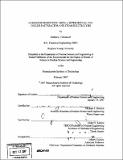Hydrogen production using a supercritical CO₂-cooled fast reactor and steam electrolysis
Author(s)
Memmott, Matthew J
DownloadFull printable version (10.76Mb)
Alternative title
Hydrogen production using a S-CO₂-cooled fast reactor and steam electrolysis
Other Contributors
Massachusetts Institute of Technology. Dept. of Nuclear Science and Engineering.
Advisor
Michael J. Driscoll.
Terms of use
Metadata
Show full item recordAbstract
Rising natural gas prices and growing concern over CO₂ emissions have intensified interest in alternative methods for producing hydrogen. Nuclear energy can be used to produce hydrogen through thermochemical and/or electrochemical processes. This thesis investigates the feasibility of high temperature steam electrolysis (HTSE) coupled with an advanced gas-cooled fast reactor (GFR) utilizing supercritical carbon dioxide (S-CO₂) as the coolant. The reasons for selecting this particular reactor include fast reactor uranium resource utilization benefits, lower reactor outlet temperatures than helium-cooled reactors which ameliorate materials problems, and reduced power conversion system costs. High temperature steam electrolysis can be performed at conditions of 8500C and atmospheric pressure. However, compression of the hydrogen for pumping through pipes is unnecessary if electrolysis takes place at around 6 MPa. The reactor coolant at 6500C is used to heat the steam up to temperatures ranging between 2500C and 3500C, and the remaining heat is provided by thermal recuperation from product hydrogen and oxygen. Several different methods for integrating the hydrogen production HTSE plant with the GFR were investigated. The two most promising methods are discussed in more detail: extracting coolant from the power conversion system (PCS) turbine exhaust to boil water, and extracting coolant directly from the reactor using separate water boiler (WB) loops. Both methods have comparable thermal to electricity efficiencies (-43%) at 6500C. This relates to an overall hydrogen production efficiency of about 47%. The approach which utilizes separate WB loops has the added advantage of being able to provide emergency cooling to the reactor, and also the benefit of not interfering with the operation of the PCS. (cont.) This makes the separate WB loop integration method a more desirable scheme for hydrogen production using HTSE. The HTSE electrolysis unit adopted for the present analysis was designed by Ceramatec in coordination with INL. In this unit the steam flows into an electrolytic cell. It is separated by electron flow from a nickel-zirconium cathode to a strontium-doped lanthanum manganite anode. The optimal conditions for stack operation have been found by INL using various modeling and experimental techniques. These conditions include a 10% by volume flow of hydrogen in the feed, a stack operating temperature of 8000C, and an operating voltage of 1.2 V. The GFR integrated with the HTSE plant via separate water boiler loops was modeled in this work using the chemical engineering code ASPEN. The results of this model were benchmarked against the Idaho National Lab (INL) process, modeled using HYSIS. Both models predict a hydrogen production rate of -10.2 kg/sec (+ 0.2 kg/sec) for a 600 MWth reactor with an overall efficiency ranging between 47%-50%. The highly recuperated HTSE plant developed for the GFR can in principle be used in conjunction with a variety of other nuclear reactors, without requiring high reactor coolant outlet temperatures.
Description
Thesis (S.M.)--Massachusetts Institute of Technology, Dept. of Nuclear Science and Engineering, 2007. Includes bibliographical references (p. 118-121).
Date issued
2007Department
Massachusetts Institute of Technology. Department of Nuclear Science and EngineeringPublisher
Massachusetts Institute of Technology
Keywords
Nuclear Science and Engineering.